Please enjoy this guest post from John McCarthy, who served as the Safety Officer and Navigator for Sarah Ferguson’s recent world-record Swim Against Plastic. He is the author of “The Sexy Ugly Beautifuls“, Founder of Ocean Child, Instigator of theGREENERsurfer and Architect of SWIM FREE – Confidence Underwater. Photo above: Wofty Wild.
An eyewitness account of Sarah Ferguson’s world-first circumnavigation swim of Easter Island
Prologue
4000 people have climbed Mount Everest, 2000 people have swum the English Channel, 12 people have walked on the moon, only one person has successfully swum non-stop around Easter Island or Rapa Nui as it is known to the local inhabitants. Rapa Nui is politically part of Chile, but due to its isolation from the mainland it has retained its own cultural identity and even has its own language. This is an eyewitness account of Sarah Ferguson’s epic swim around the island which was completed at 03h15 on Saturday 16 March, local Rapa Nui time.

Sarah Ferguson gracefully glides through the water on the way to her human first. Photo: Wofty Wild.
A big idea
“You want to do what?”
“I’m going to swim around Easter Island.”
“Why?”
“They have the highest concentration of microplastics in the world. The island of Rapa Nui is being suffocated by the rest of the world’s plastic waste.”
“Couldn’t you just organize a protest, or an online petition or a beach clean-up or something like that?“ I answer.
Sarah looks at me with a look I’ve come to recognize.
“Yes, I can, but we need to do something that will make people sit up and take notice of how serious this problem is. No one has successfully swum around the island yet. If I do, then it will shine a light on what is actually a global issue not something that is limited to the strangulation of a beautiful island in the South Pacific.”
Choosing the weather window for Sarah’s swims is largely my task. For two months prior to our departure from South Africa I scour the internet for information about wind, weather and ocean currents on Rapa Nui. There is surprisingly little information out there. I ‘fly’ around the island so many times on Google Earth that my MacBook can practically fly itself around Rapa Nui. I check in with Windy and with Magic Seaweed daily, but it is only once I get to the island that I realize how complex the local combination of wind, swell, and ocean currents is. We are looking for around fifteen hours of light winds to allow Sarah to get around the two southern points of the island.
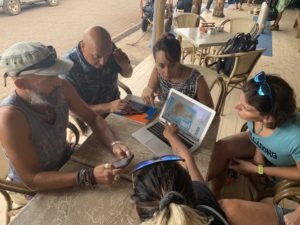
Meeting with the local team to discuss strategy and conditions. Photo: Tod Hardin.
I’m anxious to get local knowledge and on our first day there we meet with the boat captain, Marta, and the local kayak guides Tavo and Konui. They confirm my suspicion that routing would best be anti-clockwise. Sarah asks them if they believe she can be successful. They respond “Si, si!” In excited and enthusiastic Spanish. That is a huge boost to Sarah, as she needs believers on her team.
That afternoon as Sarah and Konui set out for a warm up swim, Marta, Sarah H, Wofty, Erik and I set out in Nanakua for a recce by boat around the island. The day of the recce the conditions are ferocious and instill in Sarah Houston and myself immediate respect for this ocean we’re going to attempt to escort Sarah through. Currents, winds and swell combine to create a formidable oceanic cocktail. Halfway around the island Marta informs us that we can’t go back to the port at Hanga Roa. The surf is so big the Navy has closed the harbor. We get two thirds of the way around the island where she can offload us in the protection of Anakena bay. We all leave the yacht humbled by what we’ve experienced and contemplating the magnitude of what Sarah is about to attempt.
Wiping the slate clean
The previous swimmer to attempt this swim was a man named Cristian Vergara who ended up being plucked from the ocean after 27 hours of swimming. He was in very bad shape and things only got worse for him after he left the water. Carlos the head of the local hospital and his assistant explain to us what happened to him. Exhaustion caused a collapse in his muscle tissues, this combined with hypothermia, very high sodium levels and fluid in his lungs, and a constricted throat from the prolonged exposure to the high levels of salinity in the water there, prompted the necessity of a crude make shift tracheotomy ventilation system to keep him breathing. As his body shut down in a full system collapse he was emergency medevacked to Santiago where he could be put on proper life support. He survived, but the ordeal ended up costing him thirty thousand US dollars and it left a very bad taste in the mouths of Carlos and Fernando Gallegos.
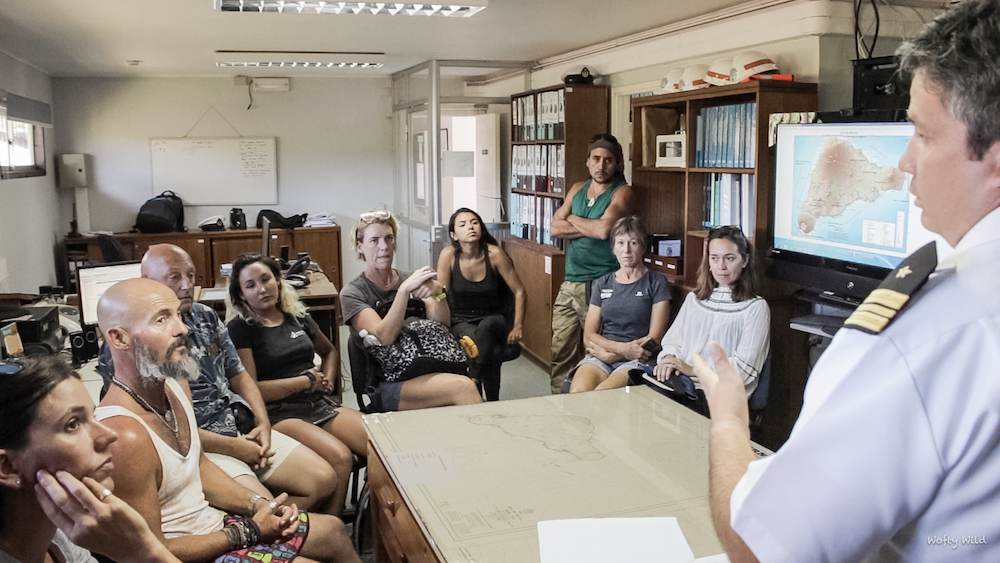
The team on the boat meets with Captain Fernando Gallegos, of the Chilean Navy. Photo: Wofty Wild.
Our first task on the island is to wipe the slate clean. Rentia does a presentation of our safety plan and the team also meets with Fernando and his staff. I do a presentation about our navigation and seconding protocol and show him our working satellite phone. Fernando is satisfied with our plan, but insists on allocating a fast-Naval patrol boat to accompany us for the duration in case we need a speedy evacuation. It appears as if a weather window is opening up for the following day and we have the green light from the hospital and the navy. It is all systems go, we load the boat the evening before and get ready for an early start the next day.
I wake to find the window that we’d seen the day before has reduced by about 8 hours. It won’t give us enough time to cross the two southern points and will leave Sarah exposed. We have to stand down.
As we chew through the next couple of days towards the next swim opportunity Sarah keeps busy with short training swims. It’s during these few days that I realize we’re in the company of a wonderfully eclectic and unique band of ocean eco warriors. Plastic Oceans International have thrown their full support into this swim. Everything from accommodation, transport and media are being organized by their highly efficient team. Tod we’ve met before with Erik in South Africa, but we finally get to meet and know the rest of the Plastic Oceans team. These guys are spread out between the US and Chile and all work virtually most of the time. Mark, Camilla aka Toto and Vivi are based in Santiago, heading up Plastic Oceans Chile. Tod is in Detroit and Julie Andersen works out of Los Angeles. On this trip Julie has brought her husband, William Pfeiffer along to assist as well as their son, Ethan. They have also organized beach clean ups, movie screenings and swimming lessons for the local kids while we are on Rapa Nui.
We were also joined by two other sponsors. Jamie Sergeant owns CROWD which is a global advertising agency and Jeff Basset is the VP of Marketing for Footprint, a progressive packaging company that focuses on biodegradable packaging alternatives to plastic. It is inspiring to be part of this broader team all united with two objectives. Firstly, reducing ocean plastic and secondly getting Sarah around Rapa Nui safely.
As Friday the 15th approaches the window stays open. This is our gap I’m certain of it. We have a blessing from Carlos and Fernando, it’s a go. The winds look light for the early and later parts of the swim, but the swell is huge. I reason that once we are beyond the breakers the huge long period swell won’t affect her adversely. Also, I reason that the middle part of the swim will be in daylight and she’ll be able to navigate both southern points with light winds in daylight. Once again, we mobilize for the swim.
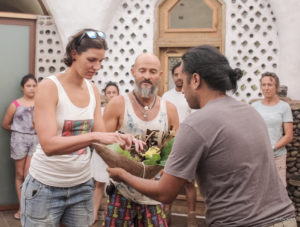
Sarah and John during the Umu ceremony, taking the offering from Mario. Photo: Wofty Wild.
The Umu
In local culture the correct thing to do before embarking on an endeavor such as this would be to hold an Umu ceremony where a chicken and some sweet potatoes are cooked in the ground with heated lava rocks. Then as this food is shared amongst the participants some of it is symbolically offered to the spirits of the ancestors and to the gods of the island. It is a ritual that asks the island for permission for us to pass through. Enrique Icka, Mario Tuki and Mahani Teave welcome us into their space. Enrique, Mario and Mahani sing in beautiful Rapa Nui as the food is distributed amongst us. Perfectly on cue, Enrique and Mahani’s young daughter, Tahai joins in. I don’t understand the words they are singing but the message is clear. They are approaching the island with respect and asking for a blessing on our mission.
Show time
Friday dawns and the door has opened for Sarah to swim. The winds are light. The surf is huge, closing out the channel. I watch with huge respect as Marta navigates a heavily loaded Zodiac back to Nanakua filled with our precious team and all their equipment. Thirty seconds before or after she chooses her gap and there would have been bodies and gear floating all over the surf zone.
Sarah will start the swim on a small dock, with Sarah H accompanying her for the first mile or so, and I’ll be in the kayak.
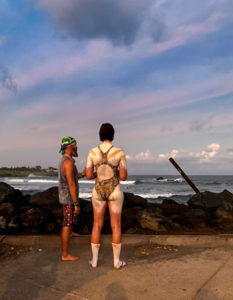
Sarah and John just prior to beginning her world-record Swim Against Plastic. Photo: Crowd.
I explain route through the surf. It’s a very long period swell, so there are gaps between the sets, but when they arrive they are ferocious. She gives a final wave and a whoop at 8:07am on Friday the 15th of March as she dives into the harbor off the dock. I sense a gap in the sets and paddle vigorously through the foam for the sanctuary of the deep blue water beyond the reef. The gate keeper here is the surf. Somehow, I squeak over the next set just as its feathering and the girls swim through, we’re out. Game on!
I immediately set a course for Hanga Piko to the south careful to stay well clear of the surf zone, any rogue waves catching us in this size of surf would be a disaster. I watch the day being born in glorious shades of pink and orange infused with rain showers in the distance over Maunga Terevaka and soft morning light.
Mataveri
As we approach the cliffs of Mataveri, not twenty minutes into the swim, Sarah says she’s feeling sick. The giant swells are smashing into the cliffs and creating backwash waves running back into the ocean. It’s a perfect cocktail to create sea sickness. From our experience in Hawaii we know what we have to do. Modesty and dignity be damned we need to get an anti-nausea suppository into Sarah as quickly as possible. Shortly after we do that we get word from the Navy that they have closed the harbor. The surf is too big to safely allow the passage of vessels in or out of the small ports of Hanga Roa and Hanga Piko. There is no going back now.
From the recce I know she’ll be tested when she makes it to the base of the southern cliffs of Rano Kai, the volcanic crater where high above is Orongo, the sacred village of the birdmen or Kavi-Kavi as they are known within the local culture.
I know that one of the wildest places I’ve ever swum in any ocean lies at the base of the cliffs below Orongo. Orongo is an ancient village perched high on the cliffs of the Ranu Kau volcanic crater. After the megalithic period on Rapa Nui famous for its giant Moai, the local tribes on the island realized that they needed a device to help them allocate the resources on the island. Instead of warring with each other they devised a contest where the fittest and strongest warrior in each tribe, of which there were at least twelve scattered over the island, would gather annually to compete in the Kavi-Kavi or birdman ceremony as it is spoken of now. This was an event that saw these young men scale down these giant cliffs which reach five hundred meters to the ocean below. There they would paddle a crude reed raft across the channel to Motu Nui, the small island a mile to the south west of the cliffs. There they would have to scale the cliffs and find the egg of the Manutara bird. Securing the egg in the folds of their hair, they would then have to return across the channel and climb the giant cliffs. The first warrior back to Orongo with his egg intact would secure the leadership rights for his tribe for the next year. It was an undertaking of great courage and athletic ability and matched the task that Sarah faced as she rounded the cliffs.
It was like the spirits of these ancient warriors came down from the cliffs to help guide and encourage their modern-day kindred spirit. As we rounded the point a cheer rang out from the boat. I looked up to see the imposing façade of Poike to the north emerge from behind the black rock of the Rano Kau Volcanic crater, the resting place of Hotu Matua, the first Rapa Nui king. Sarah celebrated by flashing a shaka and the boat crew blasted Thunderstruck by AC/DC in celebration. As we round the base of Rano Kau a storm lumbers into position behind us. The dark clouds are menacing and rain and wind whip the surface of the ocean around it into a frenzy.
The Three Bays
Vinapu to Vaihu
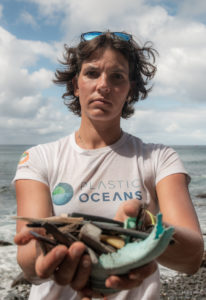
Sarah is not a happy camper upon witnessing first-hand the severity of the plastic pollution problem on Rapa Nui. Photo: Wofty Wild.
320kgs of plastic is pulled by the Plastic Oceans team from the base of this little cove in a matter of hours. When we walk these cliffs and coves days later our hearts break with the volume of plastic driven into the rocks. Sarah swallows hard and blinks. Her face flushes and I see the rising anger sharpen her features. She collects what she can.
The swell on the day we pass that bay is gigantic. As we approach Vaihu, the winds that have been kind to us all morning shift slightly and increase in strength. Sarah is swimming in a straight line from Ranu Kau to Poike, so she is cutting across the three distinct bays of the South Coast. Sarah takes a foot of wind chop into her face every time she breaths to the left. Out here in the ocean, there is no respite and the wind is increasing. It’s hard work in the kayak and it’s getting harder, I can only imagine what it must be like to swim through.
Sarah Houston can see she’s slipped into a down period. The chemistry between these two women is extraordinary. In a separate conversation I have with Sarah Houston I ask her why they work so well together.
She responds.
“Not only is Sarah talented, but she has a work ethic to match. She leaves no stone unturned in ensuring she’s prepared. I came with a complimentary nature and skill set. We recognize that we bring out the best in each other which forges a path of trust. I always joke with her that she has a mind of a steel trapdoor. Once she’s swung it shut on an idea it is as good as done!”
She reads Sarah’s body language the way Tavo and Konui read the ocean currents. She dons her goggles and jumps in to swim next to Sarah, matching her stroke for stroke and lifting her spirits in the process. Soon I see Sarah’s stoke lengthening and bursts of her ‘thunder kick’ become evident again.
It takes forever to reel in Rano Raraku, the birthplace of all the Moai that have become synonymous with Rapa Nui. Rano Rarakua demands a tax to pass and it’s a steep tax, this turns out to be one of the hardest parts of the swim for Sarah, but also for her crew. Rentia, who never gets sea sick, has succumbed in the increasingly rough conditions. Erik has so much medication in him he is batting to stay awake. Tavo is injured when returning from his stint on the kayak to the boat, as a wind swell tilts the boat as he is jumping, causing him to lose his footing and bash his shin against the side of the boat. Blood spurts from the injury immediately. Despite her sea sickness Rentia cleans the wound with assistance from Wofty and Toto. Tavo, true to his nature, grits his teeth and soldiers on as though it’s a mere scratch.
As a team, we’ve been so focused on the three major points of the island that we’ve forgotten that there is nearly twenty kilometers of hard swimming to be done to move between them. Rano Raraku reminds us of this in no uncertain terms. There is no turning to run with the wind, we have to swim through it until we round the island at Poike. Even if the navy hadn’t closed the harbor, mother nature has.
Tangariki
From far out to sea, we watch the fifteen Moai of Tongariki shape out of the landscape. It is as if there is an easing to our passage. The handbrake that has dogged us for the past few hours is released as the iconic Ahu holds up the fifteen giant Moai. As we approach the island sentinel of Motu Maratiri, I can see Sarah squaring up to the challenge that she now faces. Preventatively Sarah Houston insists on another anti-nausea suppository as she approaches the cliff face.
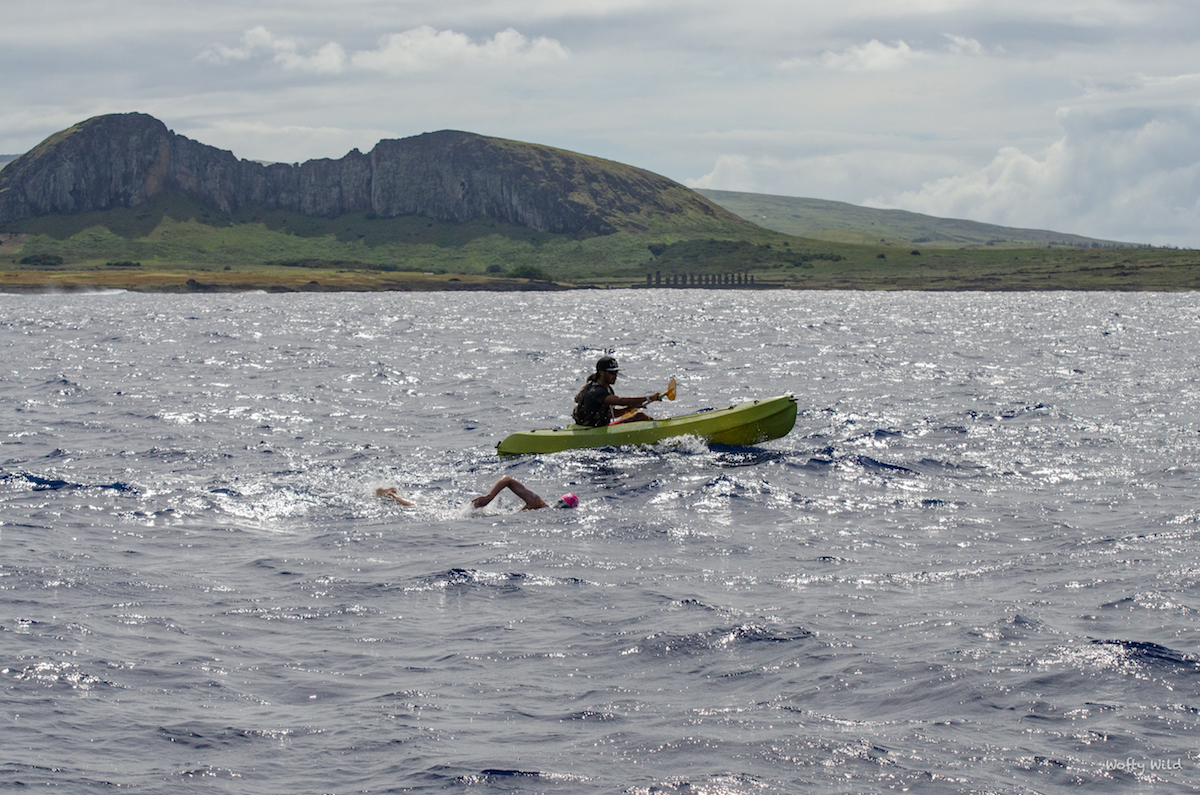
Konui leads Sarah past the Moai of Tangariki. Photo: Wofty Wild.
Mata Te Pari – Watching the whitecaps
In a private message to Kirsten Van Heerden, Sarah’s psychological coach, I describe what it is like to swim in these waters after my recce a few days previously.
“Hi Kirsten. I think this swim will give Sarah the challenge she’s looking for. I swam in six key points around the island yesterday and in two of them (the SW and NE points) I have honestly never felt such opposing forces of the ocean all colliding against each other. The water is a warm 24 degrees and very salty which makes it buoyant and the vis is off the charts at 30m plus. It’s like swimming through beautiful liquid mayhem…”
With Sarah swimming faithfully at my side I paddled us into the liquid vortex. I have no doubt in her swimming ability. I can feel the suck of the current coursing around the island taking hold of us and pulling us backwards. Progress against the cliffs slows down dramatically. Sarah swims and in between breaths I can see she’s smiling. I can’t believe it, she’s enjoying this!
I alter course slightly and half an hour later I feel us break free from the currents hold. Progress against the cliff face resumes at a satisfactory pace. We are running well ahead of schedule. She still has to swim around twenty-five kilometers after rounding the Poike point.
Anakena
As soon as we are in the northern lee of the island, the giant swells abate blocked by the land. The wind is now onshore coming over Sarah’s right shoulder. We are interrupted by the sudden appearance of a storm bearing down on us from the north. Back on the boat Marta is battening down the hatches in preparation for the wind and oncoming deluge. Visibility can be reduced to within a few feet in seconds. Magically it pauses about a kilometer from us and we swim past on towards Anakena marveling at our luck. Sarah is making good time and just before we reach Anakena darkness falls suddenly after a spectacular sunset.
The Darkness
Sarah has endured many hours of night swimming, so it’s nothing new to her, she has to gear up for it mentally. A long hard swim in the dark faces her. The first part of the swim was good, the second part was hard and I know that this last third will require vasbyt. Vasbyt is a wonderful Afrikaans word that we use in South Africa. Literally translated it means ‘bite hard’, what it means is hold on, hang in there and never give up even though you are feeling pain.
Lights flash us from the land. Clearly word has spread around the island about Sarah’s swim. Tavo and Konui flash back, signaling our response. It is a boost to Sarah to know there are people out there thinking about her.
Manga Terevaka has its own little test for us. It’s a very long corner. There is no major swell or ocean currents but the distance before you turn the corner is the killer. Finally, a cheer breaks out from Nanakua, the crew on the boat have seen the lights of Hanga Roa in the distance ten kilometers away. Sarah sighs a huge sigh and rolls over onto her back for a rest. Before she can lose her momentum Sarah H jumps in and starts swimming next to her urging her onwards. As she reaches half way down the west coast in line with the secret caves of Ana Kakenga I can tell she is really hurting.
Four kilometers from the finish and I hear three hard blasts on the whistle. This is the sign from the kayak to the boat that there is a problem. Sarah H shouts to me that she needs a bronchodilator and glycerin. Sarah’s throat is closing up from prolonged exposure to the very high salinity of the sea water around the island. My thoughts escape to the complications that unfolded for Cristian Vergara, and my heart sinks. There is no way I can allow Sarah to get that close to danger. I return with the bronchodilator and glycerin. Rentia also makes the trip out to assess her and is assured that for the time being she might be uncomfortable, but she is not critical and still good to swim. The last two kilometers are excruciatingly slow and painful for her. I’m on the kayak when Marta brings me a message from the Navy. The port is still closed due to the giant swell and they want us to terminate the swim behind backline. I know this will be a bittersweet way to conclude such a heroic effort but in good conscience I know that I can’t guide her through the gap in the rocks. Sarah tells me in no uncertain terms she definitely wants to finish where she started. I hastily convene a discussion with Konui and Tavo. This is their turf. They feel confident they can find the entrance in the reef that will enable her passage back into the port safely. For anyone else this would be sheer madness.
On the beach I can hear firecrackers, cheering and shouts of encouragement. Clearly word has spread about the crazy South African girl who has swum around the island and even though it is three in the morning many locals have come down to see history being made with their own eyes. At that moment out of the darkness emerges a Rapa Nui fishing boat. Unbeknown to us, a friend of Tavo’s has slipped out of the port somehow to offer his assistance. Clearly the Rapa Nui and the Navy have different definitions of what constitutes a ‘çlosed’ harbor. Tavo and Konui both climb on the double kayak and I jump back in the water with my fins to swim with the two Sarah’s for the final stretch.
The Beautiful People
Sarah is confident in her ability to swim long distances in the ocean, often in adverse conditions. She is driven by her faith and a desire to leave the world a better place than she found it. When she started doing these long swims several years ago, there wasn’t nearly as much awareness for the dangers that plastic poses to our oceans as there is now. There is a growing groundswell of activism and awareness that Sarah is proudly part of. She’s quick to point out that she is just one person doing what she can, but perhaps what she didn’t realize was the uniting effect that her swim would have on both the visiting and local environmental activists. Her objective gave us all a common goal and united us in a way we never expected. It forged bonds between all of us that were as welcome as they were unexpected. From the support team on the beach, to the crew on the boat to the two amazing kayak guides, the Navy boat and our last-minute addition of a rogue fishing boat, to the locals who streamed down to the docks everyone’s objective was focused on one thing. Sarah finishing the swim successfully and safely.
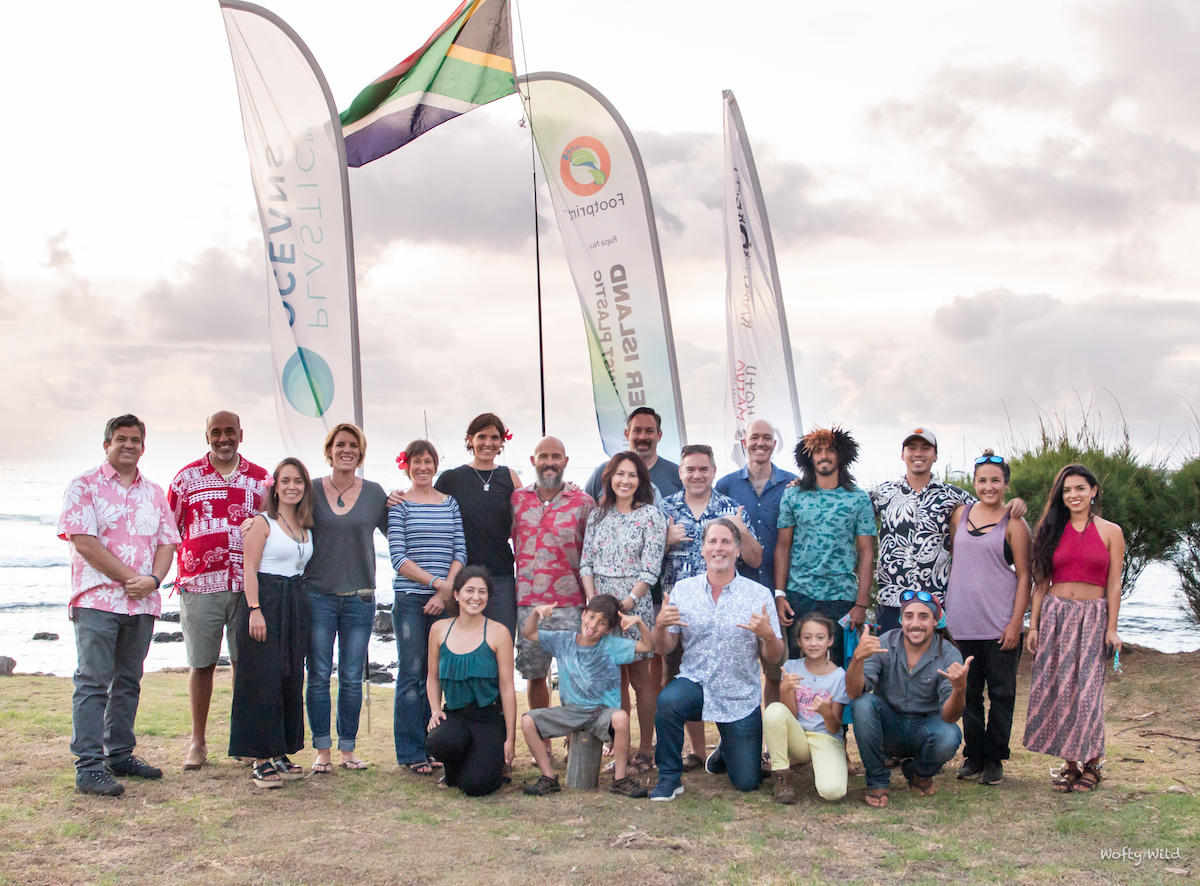
Just some of then many great individuals that made Sarah’s swim possible. Photo: Wofty Wild.
Tataku Vave – Counting the waves
As we approached the point at which we would turn left and swim through the surf back to the harbor, Tavo and Konui and the fishing boat paused. We were lined up with the swimmers in front, the kayakers a little further out, and the fishing boat further out still. Suddenly through the darkness we hear shouts from the fishing boat. Then Tavo and Konui are shouting to us “Go! Go! Go!” They urge as they launch the kayak forward with perfect symmetry in their powerful strokes.
Tataku Vave means ‘counting the waves’ for the local Rapa Nui people, whose ancestors observed the ritual exactly as Tavo and Konui did timing the sets.
Sarah rounds the harbor as I hear the first of a giant set wave break outside and close out the channel, but we are safe. Tavo and Konui have timed our entry to perfection. Sarah H and I trail Sarah as she swims up towards the jetty. Spontaneously she explodes into a butterfly stroke to finish her swim on the strongest possible note she can. I can hear Sarah H laughing next to me. The harbor is in uproar. We catch Sarah as she stops swimming at the step of the jetty exactly where she started swimming nineteen hours and eight minutes previously. We embrace in the water, Tavo dives off the kayak and joins in the group hug. It’s a magical moment and it is real, she’s done it, a new world first in swimming, but so much more than that! She’s united a global band of eco warriors with the local custodians of Rapa Nui culture. She has reached across international borders, and complex cultural minefields to unite everyone from the Captain of the Chilean Navy in Rapa Nui to the local fishermen and people who came down to the docks to support her. On the other side of the world news reaches South Africa and her fans and supporters cheer loudly for her there too.
Leis are placed around Sarah’s neck and a crown of flowers on her head as she leaves the water. She is allowed a brief celebration before being whisked away by Carlos, the director of the local hospital for a comprehensive medical checkup. The rest of her team linger on the dock a little while longer exchanging hugs with each other and the locals who’ve come down to support Sarah. The vibe is amazing a complete celebration of success.
Tears in the moonlight
It feels as if the island allowed us to travel around her on this day. As we arrived at each ‘door’ in our journey it magically opened for us and then clanged shut behind us. I explained all this to Ale as we bumped over the rutted roads back to the hotel after the swim. I looked up at the stars and the setting yellow half-moon that had perfectly illuminated the entire night time part of the swim. I look back to Ale, she is crying, silent tears of joy streaming down her face. She explains to me you cannot live here and not be connected to the island, it’s a living breathing thing. She says our mana was good today. I agree. As we bump down the rutted tracks I feel a dawning spirituality in me.
I recall my discussion with Mario Tuki. He explains that many people think of mana as power, but he likes to think of it as synchronicity. This makes so much sense to me in the context of Sarah’s swim. He reminds me of the Umu ceremony which they held for us prior to the swim.
“Sometimes if we forget to ask for permission, the island reminds us to ask for it.” He smiles as he says this.
“It is normal for us to have a spiritual connection to the land, but perhaps the feeling is more profound to people who don’t usually live with that level of spiritual awareness. The island can also wake your demons.”
I ponder how closely the local Rapa Nui people live to nature, and how deep the appreciation and love of the land and sea they live in and on is. I imagine how offensive it must be to have the rest of the world’s plastic waste wash up daily onto your shores. By having a relationship with nature, it is almost impossible not to feel this spiritual connection to the world you live in. If you have a spiritual connection with your world the last thing you want to do is fill it up with plastic and other toxic waste
Maunga Terevaka
On our last day on the island I run up Maunga Terevaka, it is the highest of all the mountains on the island on the north western corner of the island. I want to be able to take in the enormity of Sarah’s swim with one vista, where I can simultaneously view all the points of the island.
From there, I look back towards the town of Hanga Roa, the cliffs of Mataveri and onwards on to Orongo and the volcanic crater of Rano Kau. My head turns left as I sweep along the three bays of the south side towards the back of Rano Raraku and onwards to Poike and Mata Te Pari. All around the island and dotted in the ocean are little rain showers. My eyes caress the north coastline as I continue my anticlockwise journey past Anakena to where I now stand on Maunga Terevaka. From there I turn my head and complete the circumnavigation back to Hanga Roa in the distance.
To achieve what she did, she had to be the best possible version of herself and perform at her peak and she was supported by an amazing team of sponsors, guides and seconds who shared her passion. As I turn to run back down the mountain I resolve to reach a little higher and dig a little deeper in my own endeavors to live more harmoniously in Nature.
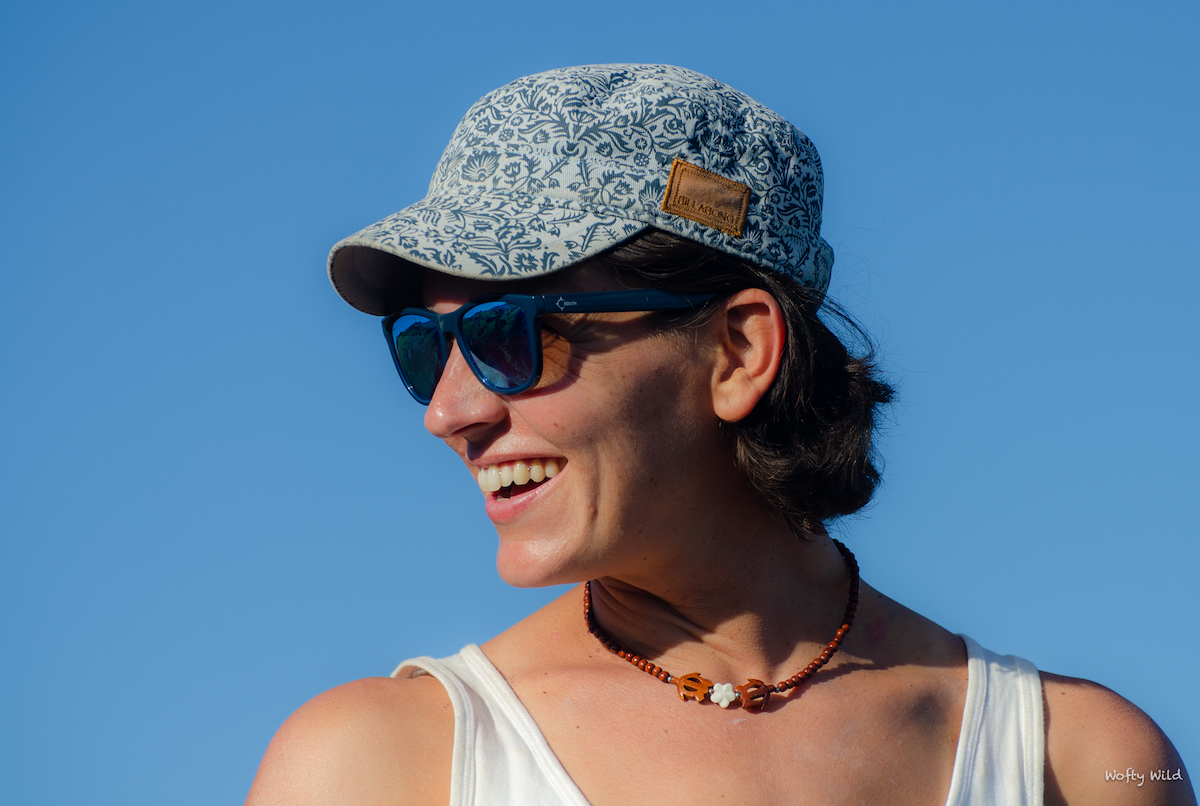
Sarah … all smiles. Photo: Wofty Wild.
Acknowledgements and thanks
To all the people of Rapa Nui who welcomed us so warmly to your beautiful island, to Sarah Ferguson for including me on your team, to the rest of Sarah’s support team, Sarah Houston as coach, Rentia Denissen, Sarah’s sport medicine practitioner and homeopath, Angelika Sandri, the most amazingly gifted masseuse, Kirsten Van Heerden her friend, fellow swimmer and psychological coach, Lynne Mackey her biokineticist, Kerry Gibson her sports nutritionist. You all help to bring out the best in Sarah.
Karl Oftebro aka ‘Wofty Wild’ and Erik Aleynikov thank you for documenting this adventure with such good humor and energy.
To Marta Vigoroux of Yacht Nanakua and your 2IC on Nanakua Hian Schneider thank you for your positive energy and amazing ocean skills.
To Gustavo ‘Tavo’ Ogaz, Karina Navea from Kayak Rapanui and Te Manu Ko Nui Gabriel Lillo, my fellow kayakers, you are my brothers and sister from the ocean. Thank you for your energy, knowledge and expert guidance.
To Fernando Gallegos Captain of the Hanga Roa Harbor, thank you for believing in us, giving us permission to do the swim and for allocating a fast Navy boat to provide assistance if needed.
To Carlos Schlack Medical Doctor and head of the hospital on Rapa Nui, thank you for your comprehensive dedication to protecting Sarah’s well being. Your post swim care of her definitely helped speed up her recovery.
To Enrique Icka, Mahani Teave and Mario Tuki from Toki Music School, thank you for performing the Umu Ceremony for us. It was a deeply moving experience for the whole team and we have no doubt it played a large role in Sarah’s success.
To Mario Tuki, thank you for the translations and cultural insights you shared.
To Sergio Mata’u Rapu director of the documentary film Eating up Easter, thank you for the generous sharing of your knowledge about Rapa Nui and it’s culture, history and legends.
To William Pfeiffer, Julie Andersen and Tod Hardin from Plastic Oceans International. You guys were so much more than sponsors and organizers! Thank you for the support, energy and belief. I can’t wait to share another adventure with you.
To Mark Minneboo, Camila Ahrendt (aka ‘Toto’) and Viviana Pinto from Plastic Oceans Chile, thank you all so much for the amazing logistics and on the ground work you did to make sure our stay was pleasant, productive and successful.
To Jeff Basset from Footprint, thank you for your sponsorship, your big ideas and willingness to help wherever you could.
To Jamie Sergeant from Crowd, thank you for the sponsorship and encouragement, your positivity was a wonderful asset to our endeavor.
To Ále’ Alejandra Roberts and Chris from Rapanui Dream and Hotel Hotu Matua and “Vicky” Victoria Barra from Hotu Matua, your hospitality was unsurpassed, thank you for making us feel at home on the other side of the world.
To Hotel Hotu Matua, thank you for sponsoring the whole team’s stay.
To Rapanui Dream, thank you for providing the vehicles and the tour of the island.
To Miguel, Che and Patrice for taking me surfing.
To Te Mau O Te Vaikava and Ludovic Tuki Burns, thank you for the work you do removing plastic from the beaches.
###
